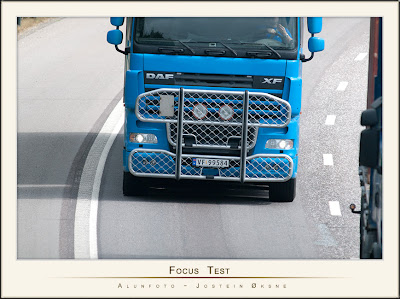Autofocus performance of Pentax K-7
Half a year ago I agonised over the K20D not being fast enough for capturing the action when photographing birds, and I sincerely wished for Pentax to build a faster camera (link to old blogpost). So when I learned about the coming K-7 I had hopes that this was the kind of camera I had wished for.
Over the last couple of days I've tried to compare the AF performance of the my K-7 to its predecessor K20D in some real-life situations. At first I was quite informal about it, just to get a feeling of the new camera. It was an enjoyable experience to track birds through the air with the K-7. When comparing the percentage of in-focus shots I got the impression that this camera was more than three times as precise as is the K20D. But that was just a gut-feeling, my photographic material was not extensive enough to draw any conclusions. For that, I needed some photographic subjects with a more predictable behaviour. So yesterday I got serious. Well... as serious as I'm capable of becoming when this kind of peeping is involved. This kind of testing is very much limited by the skill of the photographer at keeping the subject inside the frame, and within the area reachable by the 11 autofocus sensors. So take the results with a suitable measure of salt-grains. :-)
My subject of choice was trucks, driving 100 km/h on the highway just North of Oslo. I found a nice bridge where I could shoot whole series of them as they approached. Back home I studied the AF precision by inspecting the shots at 1:1 in Adobe Bridge CS4. I took a conservative approach, and judged everything that wasn't pin sharp at the front of the car to be mis-focused. The typical determinators were details in the grille or the number plates, as in the two examples below, shot with the K-7 and FA*600/4.

The camera settings were:
- SR on for shots with DA*300, shot freehand
- SR off for shots with FA*600, shot from tripod
- AF-C, multipoint
- ISO 800
- Av-mode (aperture set to f/8. shutter speed varied between 1/250s and 1/4000s)
- DNG file format
Between each series I allowed the camera to save all files before commencing a new series, to make sure camera speed was not held back by a full buffer.
Results:
1. K20D + DA*300/4:
13% mis-focused, averaged over 9 series
2. K-7 + DA*300/4:
7% mis-focused, averaged over 7 series
3. K20D + FA*600/4:
43% mis-focused, averaged over 7 series
4. K-7 + FA*600/4:
25% mis-focused, averaged over 11 series
Each series held between 10 and 19 shots.
So on the whole, I "lost" 50% less shots to mis-focus with the K-7 than I lost with K20D. That's quite an improvement, in my opinion.
Both lenses are focus-calibrated with the K20D, but not with the K-7. I therefore suspect that the K-7 results could be even further improved. Somewhat.
However, there are many other factors influencing this result. I may have misjudged the focus, and the mis-focus may have been caused by motion blur. For example, if a truck has no cargo, it tends to bounce more after passing dents or bumps in the road. I'm pretty sure my longest shutter speeds were inadequate for freezing this kind of motion, but when comparing mis-focus to shutter speeds, I can't see that the shortest shutter speeds (1/2500 - 1/4000) has fewer mis-focused shots than have the longest shutter speeds (1/250 - 1/640). Yet I can't rule out this effect, particularly for the series with the 600mm.
So back to the mentioned measure of salt, this is not a scientific study. However, I feel for my own part that the K-7 is vastly improving my odds of obtaining sharp pictures of moving subjects.

